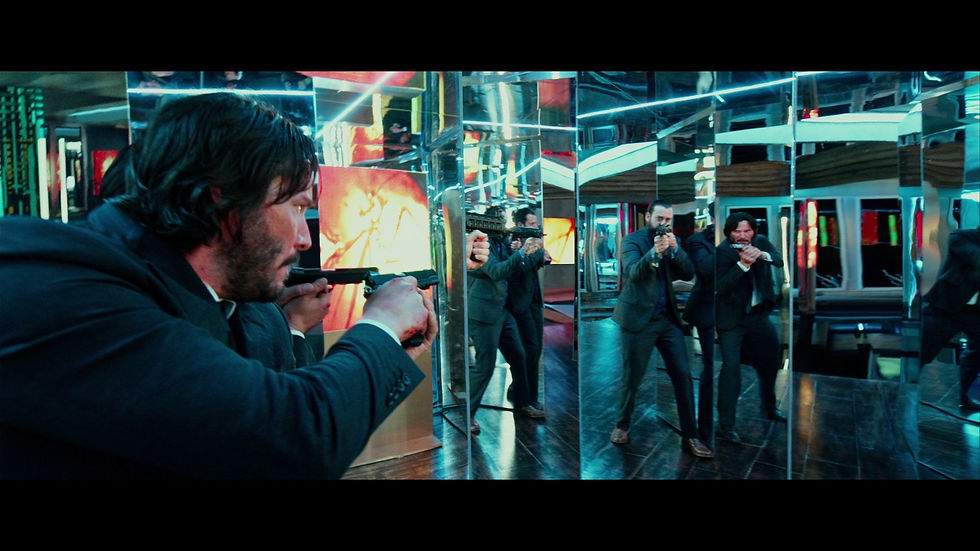John Wick 4: Action Was. Action Is. Action Will Be....
- Roman Arbisi

- Apr 5, 2023
- 7 min read

Before George Miller returned to the dystopian roads of Mad Max and Chris McQuarrie relit the fuse of Mission: Impossible in 2015, Chad Stahelski and David Leitch almost lost John Wick to the direct to video platform. A film that would have had no issue finding a niche audience, but like many other DTV actioners – the spotlight would shine elsewhere. Leaving a special film like John Wick to the shadowed peripherals of genre excellence. In a post-Dark Knight and (stampeding) MCU world, the action film was being reconfigured to drape the superheroes and heroines of splashy comic-book pages. Few of them managed to look at action as an extension of primal human instinct, and many were starting to view it as mindless fodder to distract us from how silly the world ending scenarios really were. If you measure the cuts in these films compared to John Wick, you’ll know which filmmakers love action, and just how many are scared of it.
In this moment between capes, rekindled, revamped franchises, John Wick was forged – eventually becoming a franchise all its own. A thrilling success story for the little DTV movie that could, and yet none of us knew how special that story would be until it evolved through the subsequent sequels. Now, nearly nine years removed from that October 24, 2014, release date - John Wick: Chapter 4 is here. Soon, we will be able to recognize this chapter as a landmark in action film history as we trace the countless strands of D.N.A that leads back to the inception.
John Wick: Chapter 2 wasted no time using the projection of a Buster Keaton film as an expression of adoration for the godfather of physical acting. Keaton mounting a moving train in The General is one of the most iconic (and frankly unbelievable) stunts of all-time. In 1926 no one could have conceived of doing such a thing. It reshaped how audiences would view the danger that an actor could face on set, and to think he may have one-upped it in 1928’s Steamboat Bill Jr. One man being unafraid of the frame of a house crushing him beneath its fall is the type of man that loves the thrill that a stunt could expel – that a voice simply couldn’t. To Keaton it was just another day at the office. To the audience it was a chance at seeing human life living on the fringes of death, and that concept has thrilled us since the beginning.
This is the type of energy that Chad Stahelski and David Leitch conceived in the original Wick. Instead of falling frames and moving trains – it was muzzle flash, ground and pound grappling, neon infused lighting techniques within a structure as simple as telling time. The series shortly became Chad Stahelski’s lone sandbox, and he invited all of his friends, inspirations, and icons of the craft to join him in building the thresholds that would erect the action movie monument of the fourth entry.
Like Toshiro Mifuné’s, Yojimbo, or Clint Eastwood’s, “The Man with No Name”, John Wick is a man of few words with a name that speaks with a haunting presence to those within his radius. Like his forefathers, this becomes a definitive trait we can associate with Wick as he glides across the pavement of New York, the brick paths of Rome, or the glistening marble of Paris. It isn’t so much about what he says, but how Keanu Reeves is able to articulate the nuances of John Wick in his movement. In Chapter 4 you will see the most heightened form of this expression.

In wielding nunchaku, he can slap body armored baddies, or use the weapon as a defense mechanism to tie them up as he reaches for their firearm and blasts a hole into an incoming attacker. Or maybe he’ll be forced to the ground and scramble across glass-littered floorboards with his elbows and knees in a nearly inhuman dance move. This is punctuated by evading explosive gunfire and drawing his cloak (his suit) over his face as a ballistic shield in defense. This mode of survival isn’t second nature to John - it is the nature of his existence. Stahelski is able to explore this by embracing how light can be used as a viable source of highlighting the specifics of their contribution to the form. Most contemporary filmmakers hide their action behind gnarly cuts and foggy lighting to observe uninspired sensations. Stahelski uses the camera to find the light in the setting to become a semi-primal accent to the mayhem.
Whether he is using a flashlight to burst the aperture open, or some shade of neon to etch the silhouettes of his subjects into a setting, Stahelski is constantly finding new ways to highlight action. It’s not so much what is being done, because any movie can do cool tricks, it’s how he is allowing light to infiltrate the camera to draw us into the primal nature of movement through action. It presents the images as something infallible because the edit doesn’t have to hide what is being done. The edit is only embraced to connect the next sequence of movement by way of tying two unique strands of something succinct in their own rights. The action may be taking place in the same room, but how Stahelski chooses to connect a stumble into a striking pose of reaction allows the action to sing without opening its mouth at all.
In between the splashes of physical splendor, the story keeps it lean and economic. Writers Derek Kolstad, Michael Finch, and Shay Hatten have no problem sprinkling bare details of history behind the series’ largest cast yet. The genius behind this is that they leave enough room for our interpretation, as well as using it as the driving force of action for each respective character. As an audience we are able to engage with the personalities of the cast in how they interact with one another. Sure, they’ll vaguely mention what their relationship was before the events of the first film, but their partnership explores that synchrony through physical altercation. What type of punches are pulled? How many chances are given? In a world that is repeatedly under fire; how are those choices made to distinguish the bonds of family within a hierarchy?

JW4 explores this with ease as the action becomes their vows and their words the fortresses of that promise. In their own right, these vessels of action are still people too. It may be too meta-textual to say that JW4 is an alert to all that stunt work is an art as eloquent and meaningful as spoken word, but there is a broiling text that is unafraid of hiding the commitment that has been given to the craft. The levels this film goes to not only elevate what action can accomplish but to strengthen the roles within brotherhood, sisterhood, falsehood, fatherhood, and self-commitment is not to be ignored. The people behind-the-scenes that are able to choreograph and articulate the level of thrill that cinema can provide is rooted in their own form of artistry that can be as equal as the most recognized roles in a production. They too are searching for life’s meaning in the only way they know how to artistically express it. That can be a level of emphasis that allows us to realize that these people are brothers, sisters, sons, daughters, husbands, and wives to another, and the characters of John Wick are those very people too.
John Wick: loving husband, friend, formal equal, former retiree, and The Baba Yaga, is always identified as such. For how often the audience identifies him as a certifiable badass, it is his relationship with the supporting cast that makes him more than an avatar of contemporary violence. It embroiders John with emotional connection, palpable relationships, and stark motivation to survive as he had before the first entry.
These brief emotional crutches that carries John through the violent interludes of lock, stock, and smoking barrels is the type of support that has uplifted the Wick saga through the mounds of mediocrity around it. Just when it seemed like American action films were hitting a plateau of familiarity, Wick totally revitalized the culture, and we haven’t looked back. Sure, we’ve had to endure frames full of misused neon and silent protagonists with a muted personality since, but it reignited what action films were capable of when they’re made by people who care. Especially for a budget as low, and free from the restraints of recognizable IP.
This is how most of the all-time greats became the respective cornerstones of the genre. They revel in simple strokes and gestures to invite the viewer into its realm, and then they’d unleash the most unbelievable and technically coordinated sequences of physical exertion we could hardly comprehend. This is John Wick 4 from beginning to end. It stays true to its identity as a respective franchise while it simultaneously utilizes the steppingstones of before to become the building blocks of the gateway into the next generation of action filmmaking. It bursts with flashes of drama to keep the core of John’s journey intact, and then it lets the camera loose to profile the endless levels of craftsmanship on display.

The camera cranes through the blueprints of mayhem, swivels through roundabouts at rush hour, crashes into walls, glass, and cars, and manipulates light at every hour that can emit a celebratory glow around the actors, stuntmen and women that are putting their bodies on the line. From every death-defying fall to the floors lined with bullet casings, Stahelski presents John Wick 4 as a thrilling amalgamation of what was, as a finale that caps what is, in an effort that’ll be remembered as one that redefined what it will be. Through every moment of this multi-houred experience there is a mode of inspiration that is projected onto the texture of the film and refracted back onto us.
John Wick 4 unlocks the catharsis that all great films and heroes are searching for beneath the early morning rays of sunlight that sparks the dawn of a new age in action cinema. The golden hours of this film services John Wick, while it also bows to Buster Keaton, Sergio Leone, Donnie Yen, The Raid, Mission: Impossible, The Matrix, John Woo, Jesse V. Johnson, Keanu Reeves, and the countless, unheralded efforts of the stuntmen and women that made us believe a human could survive a fall, get back up from a bone-crushing haymaker, or showcase what the human body has always been capable of being. A physical vessel that electrifies the audience with a new way of understanding how much you have to give yourself to the art of creation.
Stahelski shines a light on it, and this time it is too bright to ignore. Bravo.






Comments